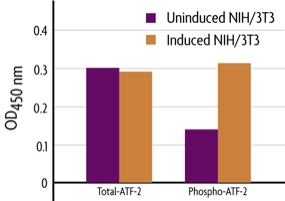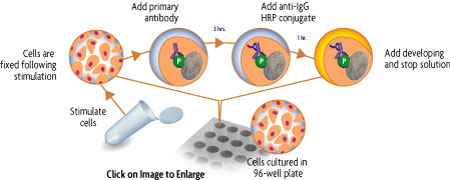FACE™ ATF-2
FACE-ATF-2-AM134
Synonyms
| Name | Format | Cat No. | Price |
|---|
Overview
THIS PRODUCT IS DISCONTINUED
Fast Activated Cell-based ELISA (FACE™) Kits provide a simple, sensitive method for detecting protein phosphorylation directly in the cell, without making extracts or performing electrophoresis and membrane blotting. These 96-well, high-throughput assays are available in both colorimetric and chemiluminescent formats for over 20 different targets (see list at right). For complete details, click the FACE™ Method tab below.
FACE ATF-2 Kits provide 96 rxns each of 2 antibodies that enable you to monitor and compare the levels of both phosphorylated and total ATF-2. The phospho-ATF-2 antibody recognizes ATF-2 when dually phosphorylated at Thr69/71 as well as when singly phosphorylated at Thr71; the total-ATF-2 antibody recognizes ATF-2 regardless of the phosphorylation state. Click the ATF-2 Info tab below for data and more information.
ATF-2 Info

Figure 1: Measurement of phosphorylated and total ATF-2.NIH/3T3 cells were cultured in 96-well plates and serum-starved for 16 hours. Cells were then treated with 25 µg/ml of anisomycin for 30 minutes and fixed. Total and phospho ATF-2 were each assayed in triplicate using the phospho and total ATF-2 antibodies included in the FACE ATF-2 Kit. Data was plotted after correction for cell number (performed through use of Crystal Violet).
Antibody Specificities
The phospho-ATF-2 antibody is specific for phosphorylated ATF-2 and was raised against a synthetic phospho-peptide corresponding to residues surrounding Thr71 of human ATF-2. This antibody recognizes ATF-2 when phosphorylated at this site and does not cross-react with c-Jun, CREB or other transcription factors. This antibody recognizes both ATF-2 when dually phosphorylated at Thr69/71 as well as ATF-2 when singly phosphorylated at Thr71. The total-ATF-2 antibody recognizes ATF-2 proteins regardless of the phosphorylation state.
ATF-2 Overview
ATF-2 is a member of the ATF/CREB family of leucine zipper DNA binding proteins that regulate transcription. This family of transcription factors play an important role in cell growth and differentiation, as well as in stress and immune responses. ATF-2 is a nuclear protein that binds to DNA as a dimer, and can form both homo- and heterodimers with members of the ATF/CREB and Jun/Fos families. The ATF-2/c-Jun heterodimer acts as a stronger activator than the ATF-2 homodimer. ATF-2 plays a role in c-Jun-dependent cell cycle progression, cell survival and apoptosis, making efficient study methods in high demand.
FACE™ Method
The FACE™ Method
In FACE, cells are cultured in 96-well plates and stimulated to induce the pathway of interest. Following stimulation, the cells are fixed rapidly, which preserves activation-specific protein modifications. Each well is then incubated with a primary antibody specific for the activated protein of interest. Subsequent incubation with secondary HRP-conjugated antibody and developing solution provides a colorimetric or chemiluminescent readout that is quantitative and reproducible (Figure 1). The number of cells in each well can be normalized easily with the provided Crystal Violet solution. FACE Kits also contain primary antibody specific for the native inactive protein, so you can monitor both native and activated protein levels in the same experiment. FACE eliminates cellular extractions, radioactive kinase assays, time-consuming Westerns and inefficient epitope interactions that occur on membranes. FACE is a highly sensitive high-throughput assay designed for detecting activated proteins within mammalian cells.
Figure 1: Flow chart of the FACE process.
Flow chart of the FACE in cell Western method that uses a cell based ELISA to measure the levels of the native and phospho forms of signaling proteins and kinases that are activated by phosphorylation.
Contents
Contents & Storage
Two (or ten) 96-well plates for culturing cells, 96 (or 5 x 96) rxns each of two primary antibodies (1 phospho-specific, 1 specific for native protein), HRP-conjugated secondary antibody, Quenching Solution, 1X Antibody Blocking Buffer, 1X Antibody Dilution Buffer, 10X PBS, 10% Triton X-100, 1% SDS Solution, Developing and Stop Solutions, and Crystal Violet Cell Quantification Solution. Storage conditions vary from room temperature to -20°C, see manual for details. All reagents are guaranteed stable for 6 months when stored properly.

